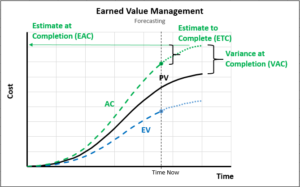 Earned Value Management contains four calculations which give the project manager a forecast into future performance of the project:
Earned Value Management contains four calculations which give the project manager a forecast into future performance of the project:
- Estimate to Complete (ETC)
- Estimate at Completion (EAC)
- Variance at Completion (VAC)
- To Complete Performance Index (TCPI)
Each of these are, in essence, an extrapolation from the previous calculation which was used to determine the status of the project right now.
Estimate to Complete (ETC)
ETC represents the expected cost required to complete the project. It measures only the future budget needed to complete the project, not the entire budget (that’s the EAC, next). It allows the project manager to compare the funding needs to finish the project with funding available.
The ETC can be calculated either for each task or for the whole project. There are two ways to calculate ETC:
- Based on past project performance:
ETC = (BAC – EV) / CPI
Since each of the input variables (right side of the equation) has been determined prior to this step, the ETC can be calculated either for each task or directly for the whole project.
- Based on a new estimate
This is called a Management ETC. This means that a new estimate of the remaining tasks in the project is performed.
In our example task we will calculate the ETC based on the past performance of the project. Once again, we will add a column to the table for ETC.
ETC = (BAC – EV) / CPI
ETC = ($10,000 – $2,000) / 0.44 = $18,182.
| ID | Name | Start | End | BAC | PV | EV | AC | SV | SPI | CV | CPI | ETC |
|---|---|---|---|---|---|---|---|---|---|---|---|---|
| 100 | Set up Database | Mar. 1 | Mar. 10 | $10,000 | $3,000 | $2,000 | $4,500 | -$1,000 | 0.67 | -$2,500 | 0.44 | $18,182 |
This task is worth $10,000 and has already spent $4,500. Don’t worry, be happy, right? Wrong. Based on its past performance we will need another $18,182 to complete it.
Of course there are often unique circumstances which caused this problem or situations which alter the future performance of the project. In these cases a Management ETC (i.e new estimate) is necessary, which is entered into the ETC column. There is nothing wrong with this practice.
Estimate at Completion (EAC)
 The EAC is the full task or project cost expected at completion (the new project budget). It can be calculated on a task by task basis or once for the entire project.
The EAC is the full task or project cost expected at completion (the new project budget). It can be calculated on a task by task basis or once for the entire project.
There are multiple ways to calculate it based on how you expect the future of the performance of the project to be:
- Future performance will be based on the budgeted cost
If you think the existing variance was a unique event and the rest of the project should go according to plan, simply add the remaining project budget to the actual cost incurred to date (AC). This method does not assume the project finishes on budget. Rather it takes into account the one time event and adjusts the whole project plan upward or downward to estimate the final result.EAC = AC + (BAC – EV) - Future cost performance will be based on past cost performance
If you think the past performance is not unusual and the past performance is a good indicator of the future, you would use this formula.EAC = AC + [(BAC – EV) / CPI] - Future cost performance will be influenced by past schedule performance
Since schedule and cost performance are usually related, there could be a reason to adjust the cost performance based on the schedule performance. For example let’s say the CPI (cost efficiency) is very low but SPI (schedule efficiency) is high, you would be justified in thinking that the final cost performance won’t likely be as bad as the CPI would suggest. In the following formula an average of the CPI and SPI are used to extrapolate the final project cost.EAC = AC + [(BAC -EV) / (CPI x SPI)]You could also use a combination of the SPI and CPI instead of a straight average. In the formula below, 20% of the SPI and 80% of the CPI has been used to determine the final project cost.
EAC = AC + [(BAC -EV) / (0.8·CPI x 0.2·SPI)] - A new estimate is produced
In this case a Management ETC can be added to the to-date cost (AC) to determine the final EAC.EAC = AC + ETC
The first two forecasting methods represent the high and low extremes, and the third represents an attempt to forecast somewhere in between those extremes. Finally, the fourth method represents a new estimate, a brand new value taken from other sources if none of the other methods are able to produce the desired result.
For example, if the project is currently over budget, the worst case scenario would have you forecasting using the current trajectory. The best case scenario would have you using the originally planned trajectory, starting from today’s date. If you feel you need to be somewhere in between, you can use a combination of the past schedule and cost performance (SPI and CPI), and if none of those alternatives give you the desired result you will need to produce a new estimate.
In our example we will predict that the current problems were caused by a one time event that isn’t likely to repeat itself. Thus, the EAC will use formula #1.
EAC = AC + (BAC – EV)
EAC = $4,500 + ($10,000 – $2,000) = $12,500.
The table now looks like this:
| ID | Name | Start | End | BAC | PV | EV | AC | SV | SPI | CV | CPI | ETC | EAC |
|---|---|---|---|---|---|---|---|---|---|---|---|---|---|
| 100 | Set up Database | Mar. 1 | Mar. 10 | $10,000 | $3,000 | $2,000 | $4,500 | -$1,000 | 0.67 | -$2,500 | 0.44 | $18,182 | $12,500 |
One can quickly see that the task, which was supposed to cost $10,000 (BAC), will now cost $12,500 (EAC).
Variance at Completion (VAC)
The VAC is a forecast of what the variance, specifically the Cost Variance (CV), will be upon the completion of the project. It is the size of the expected cost overrun or underrun. In many situations the project manager must request additional funding as early as possible, or at least report the potential for an overrun. The VAC represents the size of this request.
The formula is:
= Old Budget – New Budget
This one is relatively simple. If you’ve calculated the EAC you’ve done the big math already and the ‘new budget’ can simply be subtracted from the ‘old budget’ to determine the cost overrun or underrun.
The Variance at Completion is simply a future projected Cost Variance. It has the same units as CV. It is the same type of element.
We will once again add another column to the table:
| ID | Name | Start | End | BAC | PV | EV | AC | SV | SPI | CV | CPI | ETC | EAC | VAC |
|---|---|---|---|---|---|---|---|---|---|---|---|---|---|---|
| 100 | Set up Database | Mar. 1 | Mar. 10 | $10,000 | $3,000 | $2,000 | $4,500 | -$1,000 | 0.67 | -$2,500 | 0.44 | $18,182 | $12,500 | -$2,500 |
To Complete Performance Index (TCPI)
The TCPI represents the efficiency level, specifically the CPI, that will make the project finish on time. It can be a powerful indicator because it is generally easy to ascertain if your people will be as productive as the indicator tells you. This indicator tends to be a bigger red flag than other indicators. For example, if it says your people need to be twice as efficient as the schedule, it tends to make you take notice that action needs to be taken.
There are two ways to calculate the TCPI:
- To achieve the original budget
If the goal is to achieve the original project budget, that is, the overrun or underrun has not resulted in a change to the project schedule and/or budget, the following formula applies:TCPI = (BAC – EV) / (BAC – AC) - To achieve the EAC
If the goal is to achieve the project’s EAC, that is, a change has been made to the project and the EAC is the new project budget, use this formula. If additional funds covering the cost overrun have been requested and approved by the project sponsor, the EAC becomes the target of the project, and this scenario applies.TCPI = (BAC – EV) / (EAC – AC)
The closer the project is to completion the higher the CPI that will be necessary to complete on budget. It can become extreme near the end.
Also, if the project has already spent more than its budget the TCPI will be negative.
TCPI is the last column in the table. We will assume the project budget has not been revised (EAC is simply a projection) and the goal is still the original project budget (formula #1, above).
TCPI = (BAC – EV) / (BAC – AC)
TCPI = ($10,000 – $2,000) / ($10,000 – $4,500) = 1.45.
| ID | Name | Start | End | BAC | PV | EV | AC | SV | SPI | CV | CPI | ETC | EAC | VAC | TCPI |
|---|---|---|---|---|---|---|---|---|---|---|---|---|---|---|---|
| 100 | Set up Database | Mar. 1 | Mar. 10 | $10,000 | $3,000 | $2,000 | $4,500 | -$1,000 | 0.67 | -$2,500 | 0.44 | $18,182 | $12,500 | -$2,500 | 1.45 |
This project team must be 45% more efficient than they have been to finish on budget. A seemingly difficult task.
This completes the earned value calculations. The next page will focus on reporting the results to the various stakeholders, and then we will finish with an example.
Navigation
- Previous Page: Determine Cost Status
- Next Page: Earned Value Reporting
- Home: Earned Value Tutorial
